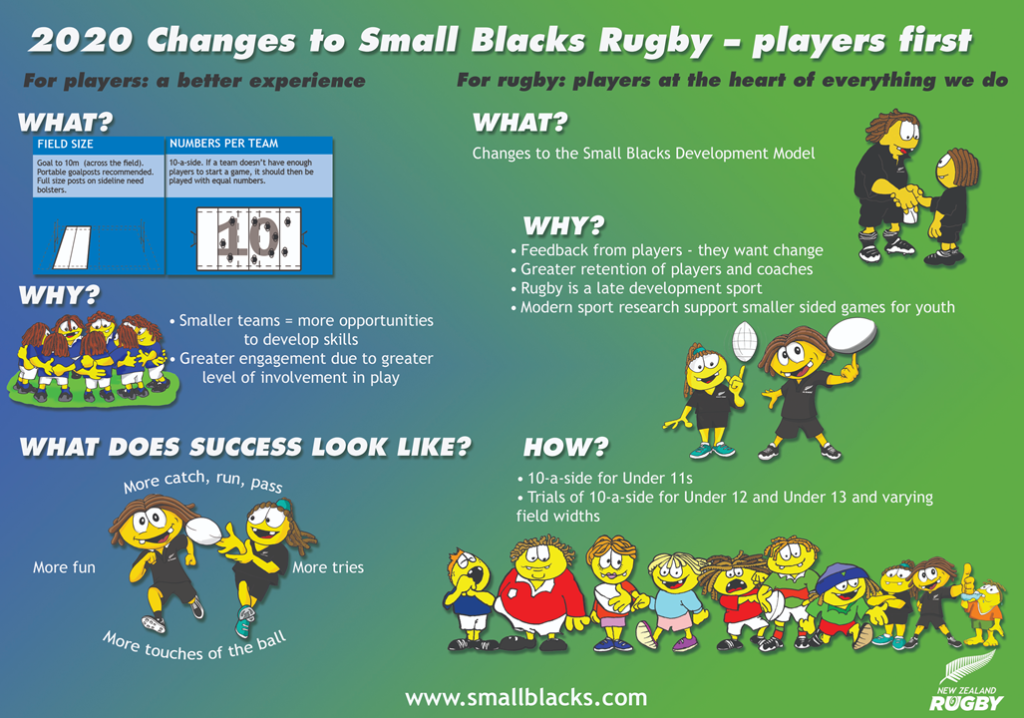In this case study, we hear from New Zealand Rugby about the change they undertook to the design and delivery of under-11 boys’ rugby competition structures. These changes were brought about in response to national year-on-year declining numbers at under-12 boys age group. This case study illustrates how competition structure changes aligned to Balance is Better were made across one sport’s network (from national to local) and the impact of these changes.
*The following video was captured at the June 2021 Sport New Zealand – Sport Development Hui.
About the New Zealand Rugby under-12 boys case study
The following case study outlines the change management process that New Zealand Rugby along with their provincial unions undertook between 2018-2021 to shift how rugby was delivered to under-11 players and improve the overall experiences of junior players. Historically, under-12 boys play full field 15-aside rugby, and for most, this would be the second season that they would be playing the full-game of rugby. In 2019, the New Zealand Rugby board signed off on rule changes to under-11 rugby competition formats. New rules would mean that from 2020 onwards under-11 club rugby throughout New Zealand would be delivered in a 10-aside format, with smaller field sizes.

It is important to recognise the context that these changes were made in. While rugby has significant cut-through into New Zealand society and is played or consumed by a lot of people, as a sport, it is also facing significant challenges.


What was the problem?
In 2018, New Zealand Rugby recognised that year on year, under-12 boys’ participation numbers were falling. Interestingly, the growth of women and girls’ rugby and their subsequent upswing in participation numbers had masked some of the significant issues being faced in the delivery of rugby to males.

How did New Zealand Rugby Union think about this problem?
Around 2018, New Zealand Rugby recognised that they needed to take a philosophical shift from delivering a sport through a game-centric mindset to one that was participant-centric. This meant they “needed to stop trying to make the players fit the game, and make the game fit the players.” This was a critical shift for New Zealand Rugby, and one they recognised would and will continue to take time to embed universally into the community, particularly because of the reverence that some stakeholders have for the ‘amateur days’.

In becoming more participant-centric in their thinking, New Zealand Rugby developed the following model to think about participants’ experiences.

In this model, ideally, the following three facets work in harmony:
- Design of the game – i.e., rules determining how game should be played
- Delivery of the game – i.e., competition formatting, often regulated and decided by organising committees
- Environment surrounding the game – i.e., how the likes of parents, coaches, clubs and schools, influence the participant experience.
Taking this approach now means rugby stakeholders are being challenged to shift from ‘thinking how to get 160,000 participants to fit one game, to how you design different types of opportunities to meet the needs of different types of participants’.
What did New Zealand Rugby do to begin addressing this problem?
New Zealand Rugby had identified that falling under-12 boys’ players numbers (in this instance) was the problem that they needed to solve; however, they were mindful to not fall into the trap of hopping onto the problem-solving treadmill but trying to address this problem with event-like interventions (e.g., more messaging, more posters etc.). Sustainable change required a system thinking approach, and New Zealand Rugby employed Daniel Kim’s Levels of Perspective to analyse the issue at large and develop an appropriate response.
By systemically unpacking the problem of declining under-12 numbers, New Zealand Rugby concluded that a large driver of this problem was due to under-11 players having a poor experience and not returning the following year.

Along with data and their own insights, New Zealand Rugby used the Daniel Kim’s framework, Levels of Perspective, to identify and analyze the problem of declining under-12 boys’ participation numbers.
What did New Zealand Rugby Union learn about implementing changes to the design and delivery of under-11 boys rugby?
New Zealand Rugby had identified the problem and were beginning to chart a course forward. At this juncture, they were cognisant that turning intent into impact would involve change. New Zealand Rugby set out to be purposeful on the change journey they would have to lead in this space, mindful that because sport is such an emotional context (and for some people it’s their only source of joy) change is often met by detractors despite well placed rationale.
New Zealand Rugby adopted Kotter’s 8-step Change Model, as their change management framework to support how they went about introducing new rules at under-11 boys rugby.

What was the response to these changes?
While bringing about smaller team sizes and smaller field sizes for under-11 rugby has not been without its detractors, overall, stakeholders in the game (especially young participants) have responded positively.
Early indicators show that there is an improvement in under-12 boys’ registrations compared to previous years.













